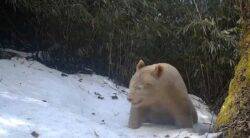To view this video please enable JavaScript, and consider upgrading to a web
browser that
supports HTML5
video
Ultra-rare footage shows the latest of just a handful of glimpses of the world’s only known albino panda since it was born five or six years ago.
The all-white bear was filmed by a motion-activated camera crossing through a vast nature reserve in the mountains of China’s Sichuan province.
It’s only the third recorded sighting of the animal, which was photographed as a cub in May 2019 and filmed in 2020 by similar devices in the area.
The new footage, which shows it interacting with typical pandas, appears to confirm for the first time that others of its kind don’t mind its unusual appearance.
While an older panda appears to chase it away at one point, other images show it playing with and being followed around by black-and-white pandas.
Li Sheng, a researcher from Peking University, told China’s state broadcaster CCTV: ‘So far we can tell that the white panda is doing very well in its species group and in the natural environment.
‘It is still unclear whether its gene will be inherited and steadily passed on in the small panda population, and more follow-up research is needed.’
The panda was spotted in the snowy mountains at Wolong National Nature Reserve (Picture: AP)
It was seen chewing on bamboo trees and frolicking with other pandas (Picture: AP)
There are still no signs of any other cases of pandas with albinism, a rare genetic mutation which makes it unable to produce the skin pigment melanin.
As well as missing its species’ characteristic black splotches, the albino panda also has distinctive red eyes.
Neither trait is believed to have caused any problems for the animal, which scientists described as healthy-looking.
The cameras which caught the footage were deliberately installed around Wolong National Nature Reserve in the hopes of studying the white panda after researchers worked out its likely routines.
There are currently fewer than 1,900 pandas in the wild, with most living in southwestern China.
The species was reclassified from endangered to vulnerable by the World Wildlife Fund after successful repopulation efforts, though it is still deemed reliant on human-led conservation efforts.
Get in touch with our news team by emailing us at [email protected].
For more stories like this, check our news page.
Scientists said the animal is healthy and appears to be interacting well with others of its kind.





